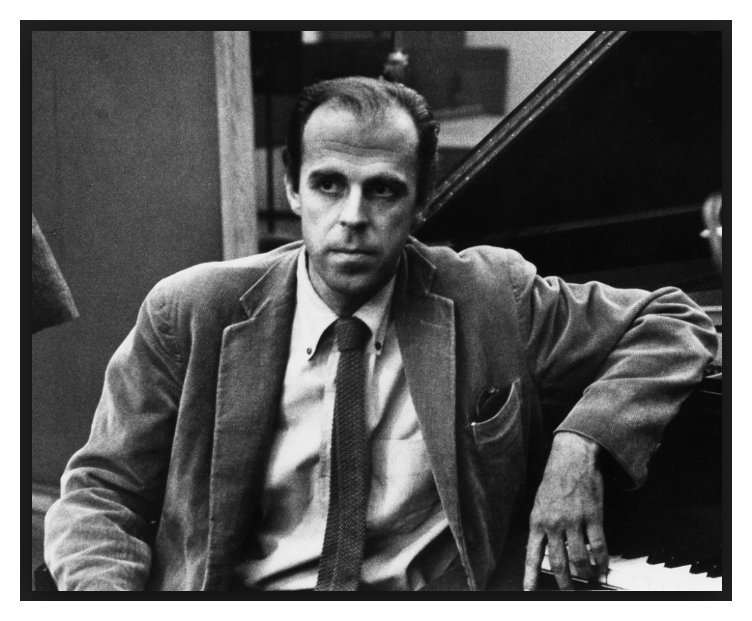

|
Earle
Brown, 75, Composer Known for Innovation, Dies
By ALLAN KOZINN Published in The New York Times, July 8, 2002 Earle Brown, an innovative experimental composer who allowed performers considerable interpretive freedom, and whose vision of sound as an almost concrete object is often expressed in a form of graphic notation that conveys the importance of time and space in his music, died on Tuesday at his home in Rye, N.Y. He was 75. Mr. Brown began his musical life as a jazz trumpeter, and in his student years he studied mathematics and engineering with the idea of a career in aeronautics. But he was also strongly drawn to contemporary painting, sculpture, poetry, dance and music, and after service in the Army Air Corps during World War II he devoted himself to more formal musical studies at the Schillinger School of Music in Boston. He moved to Denver in 1950, where he began painting as well as composing and teaching music. An encounter there with the composer John Cage in 1951 proved decisive: Cage invited Mr. Brown to New York to contribute to his ''Project for Music for Magnetic Tape.'' Mr. Brown's contribution to Cage's project was ''Octet I'' for eight loudspeakers (1953), a tactile work in which isolated tones, fragments of speech and singing, snippets or orchestral recordings and bursts of noise swirl around a listener for nearly three and a half minutes. Mr. Brown quickly became an influential member of the New York School, in which the other prominent composers were Cage, Morton Feldman, Christian Wolff and David Tudor. He adopted some of the philosophical hallmarks of Cage's approach, including the use of indeterminacy, a technique in which performers were given parameters within which they could choose what, when or how to play. One of Mr. Brown's best-known works in this style, ''December 1952,'' invites performers to interpret a visually elegant score [shown below] that consists of rectangles of different sizes and thicknesses, some horizontal, some vertical. 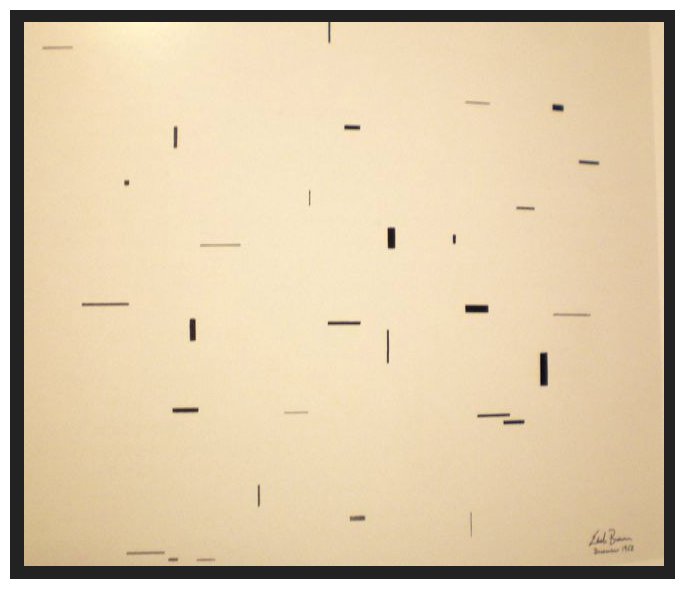 The score for ''December 1952'' has been likened to a painting by Mondrian, but Mr. Brown has said that his graphic scores were more directly inspired by the mobiles of Alexander Calder. The score for his ''Available Forms I'' (1961), also inspired by Calder, consists of six unbound pages, each of which includes four or five distinct musical events. The conductor begins the work with any event on any page and builds the work by selecting from the remaining events and manipulating tempo and dynamics at will. In the collaborative ''Calder Piece'' (1963-6), a percussion score by Mr. Brown was, in effect, performed by Calder's ''Chef d'Orchestre,'' a playable mobile. Earle Appleton Brown was born in Lunenburg, Mass., on Dec. 26, 1926. During his years as a mathematics and engineering student at Northeastern University in the early 1940's, he played trumpet in a jazz band on weekends. He continued to play jazz during his military service, and in 1946 he enrolled at the Schillinger School, where he studied composition and early music. His works in these pre-Cage years were largely in the 12-tone style, as were some of his early New York works. When Mr. Brown moved to New York to join the Cage circle, his first wife, Carolyn Brown, a dancer, joined Merce Cunningham's company. Their marriage ended in divorce. In 1972, Mr. Brown married Susan Sollins, who survives him, as does a sister, Marilyn Krysil, of Lunenburg, Mass. In New York, Mr. Brown quickly developed his own approach to Cage's chance aesthetic. But he was less enamored than Cage of pure chance composition. He later described ''December 1952'' as ''an activity rather than a piece by me, because of the content being supplied by the musicians.'' More typically, he found ways to combine ambiguous elements, in which musicians were free to make choices, with specifically notated passages, which he expected to be played with strict precision. In ''time-notation'' works like ''Music for Cello and Piano'' (1954-5), pitches and dynamics are provided in traditional notation, but durations are left to the players. In his later works -- the best-known is ''Tracking Pierrot'' (1992) -- he continued to modify the balance between fixed notation and open forms. He also continued to compose for a variety of forces, calling for huge blocks of chordal sound in some works and graceful, pointillistic webs in others. Mr. Brown music was extremely influential in Europe during the 1950's and 60's, when composers like Krzysztof Penderecki, Gyorgy Ligeti, Karlheinz Stockhausen and Franco Donatoni adopted elements of his style. (Donatoni also dedicated two orchestral works to Mr. Brown, ''To Earle I,'' in 1970, and ''To Earle II,'' in 1972.) As a teacher, Mr. Brown held the W. Alton Jones chair of composition at the Peabody Conservatory in Baltimore from 1968 to 1973. He also taught at SUNY Buffalo, Yale University and the Tanglewood and Aspen Music Festivals. As president of the Fromm Music Foundation from 1984 to 1989, he organized new music concerts at the Aspen Music Festival and commissioned works by many composers, among them Henry Brant, Ornette Coleman, Todd Machover, Steve Mackey, Steve Reich, James Tenney and Joan Tower. He was also the repertory director of an important series of new-music recordings on the Time-Mainstream label. Between 1960 and 1973, he oversaw the label's recordings of works by 49 composers from 16 countries, among them Ives, Cage, Nono, Maderna, Stockhausen, Luciano Berio and Iannis Xenakis. -- Photo of score added for
this website presentation.
-- Names which are links (in this box and below) refer to my interviews elsewhere on this website. BD |
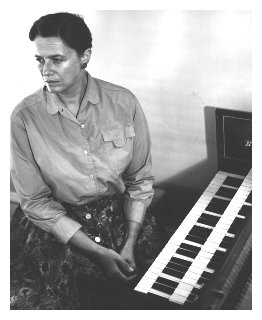 Roslyn Brogue (16 February 1919 – 1 August 1981) was an American pianist, violinist, music educator, classics scholar, poet, author and composer. She was born in Chicago, Illinois, and graduated from the University of Chicago in 1937, from Radcliffe College in 1943 and from Harvard University in 1947 with a Ph.D. After completing her education, she taught at the Cambridge School, Harvard University and Boston University. She took a position in 1962 teaching at Tufts University Department of Classics, and later taught in the Department of Music. She married composer Ervin Arthur Henning in 1944 in Massachusetts, and the couple divorced about 1969. They were among the first composers to write twelve tone compositions for recorder, Henning in 1951 and Brogue in 1955. Brogue died in Beverly, Massachusetts, and her papers are housed at Tufts University. Among her notable students is composer Earle Brown. |
 EB: No, it was
completely my own. I
first started doing these things in 1951 and ’52, and what occurred to
me, from a jazz background, was the freedom and the flexibility that
jazz
has from performance to performance.
EB: No, it was
completely my own. I
first started doing these things in 1951 and ’52, and what occurred to
me, from a jazz background, was the freedom and the flexibility that
jazz
has from performance to performance.|
Bruno Maderna - Conductor, Composer
Born: April 21, 1920 - Venice, Italy Died: November 13, 1973 - Darmstadt, Germany 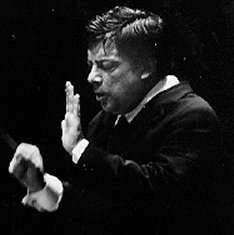 The outstanding Italian-born German conductor, composer,
and teacher, Bruno Maderna, commenced musical studies at 4, and soon
took violin lessons. He began touring as violinist and conductor when
he was only 7, appearing under the name Brunetto in Italy and abroad,
He studied at the Verdi Conservatory in Milan, with Bustini at the Rome
Conservatory (diploma in composition, 1940), and with Malpiero at the
Venice Conservatory. He also took conducting course with Guarnieri at
the Accademia Musicale Chigiana in Sienna in 1941. He then served in
the Italian Army during World War II, eventually joining the partisan
forces against the Fascists. After the war he studied conducting with
Hermann Scherchen in Darmstadt. The outstanding Italian-born German conductor, composer,
and teacher, Bruno Maderna, commenced musical studies at 4, and soon
took violin lessons. He began touring as violinist and conductor when
he was only 7, appearing under the name Brunetto in Italy and abroad,
He studied at the Verdi Conservatory in Milan, with Bustini at the Rome
Conservatory (diploma in composition, 1940), and with Malpiero at the
Venice Conservatory. He also took conducting course with Guarnieri at
the Accademia Musicale Chigiana in Sienna in 1941. He then served in
the Italian Army during World War II, eventually joining the partisan
forces against the Fascists. After the war he studied conducting with
Hermann Scherchen in Darmstadt.Bruno Maderna taught composition at the Venice Conservatory from 1947 to 1950. In 1950 he made his formal conducting debut in Munich. He subsequently became a great champion of the avant-garde. With Luciano Berio, he helped to form the Studio di Fonologia in Milan in 1954. Also with Luciano Berio, he was conductor of the RAI’s Incontri Musicali from 1956 to 1960. He taught conducting and composition in various venues, including Darmstadt (from 1954), the Salzburg Mozarteum (1967-1970), the Rotterdam Conservatory (from 1967), and the Berkshire Music Center in Tanglewood (1971-1972). He was chief conductor of the RAI in Milan from 1971. In 1963 he became naturalized German citizen. Stricken with cancer, he continued to conduct concerts as long as it was physically possible. Bruno Maderna was held in great esteem by composers of the international avant-garde, several of whom wrote special works for him. |
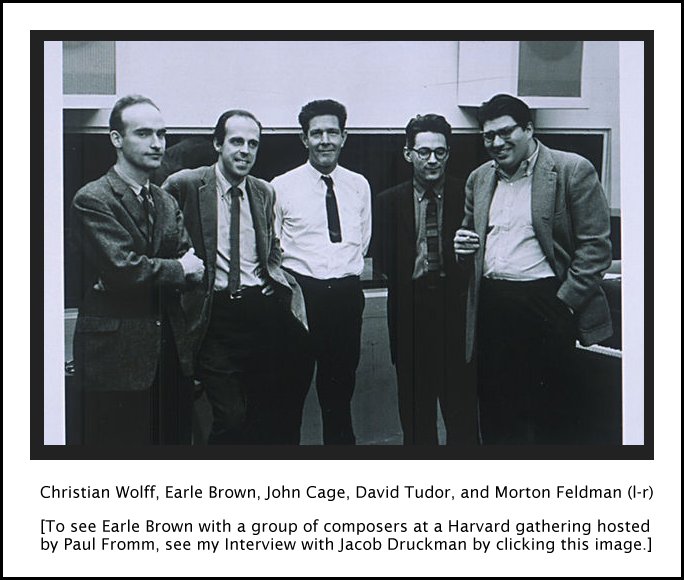 EB: Oh no,
no. I’m not a nut, you know. At a certain point when I was
a student, I came to the
conclusion that I wanted to know everything that has been done in
contemporary music, and then see if I can add to the potential, to see
if
I can add to the reservoir of compositional potential. Stravinsky
did what he did, and Schoenberg did what he did, and I’m not comparing
myself to them, but the fact is I just was not content to write
eighteen string quartets in the style of Schoenberg or Haydn or Berg,
or anybody. So I wrote uniquely. Cage has no connection
with jazz and doesn’t like it. He doesn’t like
improvisation.
Feldman had no connection to it. Of
those of us so-called wild guys — Cage,
Brown, Feldman, Christian Wolff — I was the only one that came out of
jazz. Therefore, people say to me, “How did you think to do this
in 1952?” I wondered what’s so strange about that? I was
improvising music in 1950, and even 1945.
EB: Oh no,
no. I’m not a nut, you know. At a certain point when I was
a student, I came to the
conclusion that I wanted to know everything that has been done in
contemporary music, and then see if I can add to the potential, to see
if
I can add to the reservoir of compositional potential. Stravinsky
did what he did, and Schoenberg did what he did, and I’m not comparing
myself to them, but the fact is I just was not content to write
eighteen string quartets in the style of Schoenberg or Haydn or Berg,
or anybody. So I wrote uniquely. Cage has no connection
with jazz and doesn’t like it. He doesn’t like
improvisation.
Feldman had no connection to it. Of
those of us so-called wild guys — Cage,
Brown, Feldman, Christian Wolff — I was the only one that came out of
jazz. Therefore, people say to me, “How did you think to do this
in 1952?” I wondered what’s so strange about that? I was
improvising music in 1950, and even 1945. EB: Well, yes, the
long-term judgment
of the audience is really what it’s all about. I like what I do
and I don’t always like
every piece that I write. Some I like better than others.
But the fact is that the pieces go out there, and the audiences hear
them
and I get a good reaction. One of the problems that
I’ve had is that I have always written program notes explaining the
open form concept — that this piece will be
formed differently
tonight when you hear it, and then it will
never be heard in that form again. In Munich, it was not the
first
performance of Available Forms II,
but it was the third or fourth
performance, and I explained this. There was open form that Bruno
and I were making
decisions instantaneously, having rehearsed all the material very well,
as if it were Mozart, when in the actual performance Bruno and I were
making instantaneous decisions based on what each of us was hearing,
sounding, and what continuity I was building and he would relate to, or
I was building, etcetera. So the funniest thing happened in the
review
of that Radio Munich performance. The critic said, “Well, on the
basis of Mr. Brown’s program notes, I really don’t think I can call
this a great composition, but it sounded absolutely fantastic! It
was a great performance. However, if it’s not going to sound that
way again, how can I say it’s a great piece?” [Both laugh]
I’d put in myself and critics in this kind of
difficult position. I pulled the rug out from under myself, in a
way, because if it’s not going to sound that way again... But
that indicates to me that
the critic is hung up on the concept of whether it is a masterpiece, or
was it a thrilling sonic experience? It was a thrilling sonic
experience. He said so, but he couldn’t call it a really terrific
piece of music.
EB: Well, yes, the
long-term judgment
of the audience is really what it’s all about. I like what I do
and I don’t always like
every piece that I write. Some I like better than others.
But the fact is that the pieces go out there, and the audiences hear
them
and I get a good reaction. One of the problems that
I’ve had is that I have always written program notes explaining the
open form concept — that this piece will be
formed differently
tonight when you hear it, and then it will
never be heard in that form again. In Munich, it was not the
first
performance of Available Forms II,
but it was the third or fourth
performance, and I explained this. There was open form that Bruno
and I were making
decisions instantaneously, having rehearsed all the material very well,
as if it were Mozart, when in the actual performance Bruno and I were
making instantaneous decisions based on what each of us was hearing,
sounding, and what continuity I was building and he would relate to, or
I was building, etcetera. So the funniest thing happened in the
review
of that Radio Munich performance. The critic said, “Well, on the
basis of Mr. Brown’s program notes, I really don’t think I can call
this a great composition, but it sounded absolutely fantastic! It
was a great performance. However, if it’s not going to sound that
way again, how can I say it’s a great piece?” [Both laugh]
I’d put in myself and critics in this kind of
difficult position. I pulled the rug out from under myself, in a
way, because if it’s not going to sound that way again... But
that indicates to me that
the critic is hung up on the concept of whether it is a masterpiece, or
was it a thrilling sonic experience? It was a thrilling sonic
experience. He said so, but he couldn’t call it a really terrific
piece of music. BD: And in your
case, might not exist ever again!
BD: And in your
case, might not exist ever again!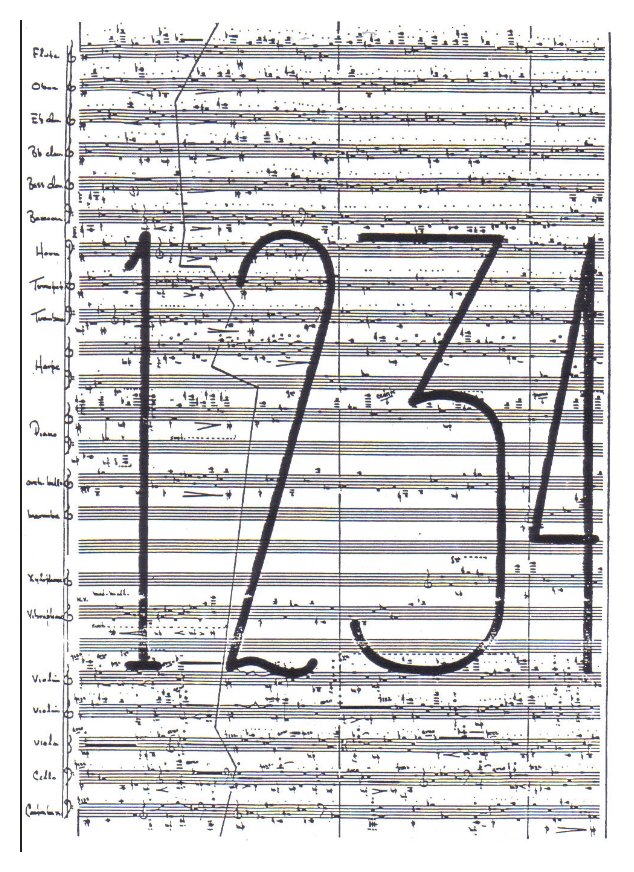 EB: Yes, and you
have to think very far in advance. When I have an open form
piece, I have to
conceive of and write the elements that will then be combined
differently over who-knows-how-many years. But there
has to be a certain integrity to the material that then can be
conducted open form, and put together in different forms. I
would challenge anybody to hear five performance of Available Forms I,
for instance, which is for eighteen instruments, and say that it is
haphazard. It’s absolutely not. A bad performance can sound
sort
of falling apart, but, as I said before, so can Mozart sound like
it’s falling apart if you don’t play it well, or conduct it well.
EB: Yes, and you
have to think very far in advance. When I have an open form
piece, I have to
conceive of and write the elements that will then be combined
differently over who-knows-how-many years. But there
has to be a certain integrity to the material that then can be
conducted open form, and put together in different forms. I
would challenge anybody to hear five performance of Available Forms I,
for instance, which is for eighteen instruments, and say that it is
haphazard. It’s absolutely not. A bad performance can sound
sort
of falling apart, but, as I said before, so can Mozart sound like
it’s falling apart if you don’t play it well, or conduct it well.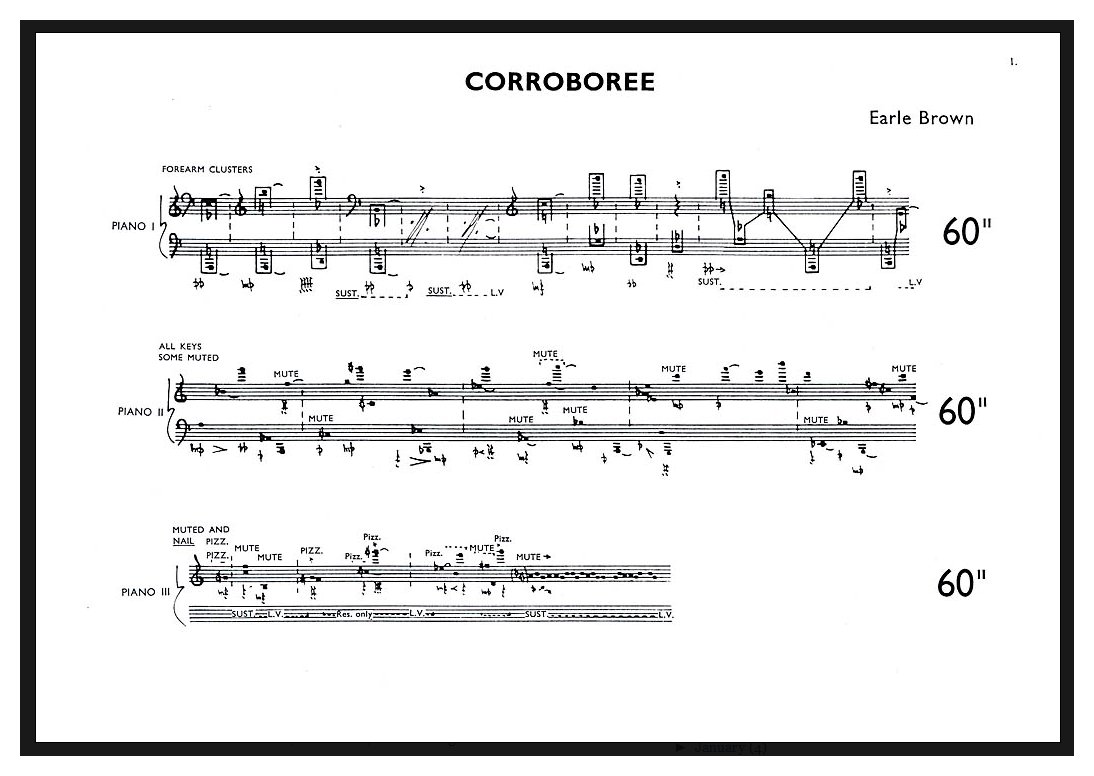
This conversation was recorded in New York City at the the home
of Earle Brown on December 12, 1991. Portions were broadcast on
WNIB a couple of week later,
and again in 1996, and on WNUR in 2006 and 2008. This
transcription was made in 2014, and posted on this
website
at that time.
To see a full list (with links) of interviews which have been transcribed and posted on this website, click here.
Award - winning broadcaster Bruce Duffie was with WNIB, Classical 97 in Chicago from 1975 until its final moment as a classical station in February of 2001. His interviews have also appeared in various magazines and journals since 1980, and he now continues his broadcast series on WNUR-FM, as well as on Contemporary Classical Internet Radio.
You are invited to visit his website for more information about his work, including selected transcripts of other interviews, plus a full list of his guests. He would also like to call your attention to the photos and information about his grandfather, who was a pioneer in the automotive field more than a century ago. You may also send him E-Mail with comments, questions and suggestions.